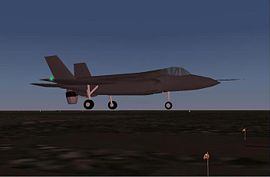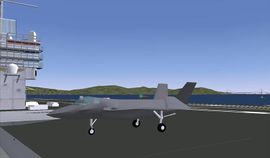F-35 Lightning II
From wiki.flightgear.org
| F-35 Lightning II | |
|---|---|
 | |
| Type | Stealth multirole fighter |
| Author(s) | Gijs de Rooy, Detlef Faber (FDM), Reece Thomas |
| Status | Development, not released |
| FDM | YASim |
| --aircraft | F-35A, F-35B, F-35C |
| Current user rating: 0% (0 votes)
You need to enable Javascript to vote
| |
The Lockheed Martin F-35 Lightning II is a fifth-generation, single-seat, single-engine, stealth-capable military strike fighter, a multirole aircraft that can perform close air support, tactical bombing, and air defense missions.
Contents |
Variants
Currently two variants are being modeled in FlightGear: the B and C. The A variant might follow later on.
- F-35A: is the conventional takeoff and landing (CTOL) variant intended for the US Air Force and other air forces. It is the smallest, lightest F-35 version and is the only variant equipped with an internal cannon.
- F-35B: is the short takeoff and vertical landing (STOVL) variant of the aircraft. Similar in size to the A variant, the B sacrifices some fuel volume to make room for the vertical flight system. Takeoffs and landing with vertical flight system are by far the riskiest, and in the end, a decisive factor in design.
- F-35C: carrier variant will have a larger, folding wing and larger control surfaces for improved low-speed control, and stronger landing gear for the stresses of carrier landings. The larger wing area allows for decreased landing speed and increased range and payload.
Aircraft help
| Key | Function |
|---|---|
| C | Open/close canopy |
| F | Fold/unfold wings (F-35B) |
| m/M | Rotate nozzle |
Takeoff
Carrier takeoff
- Taxi to the catapult.
- Engage the plane to the catapult and unfold the wings.
- Lower your flaps and apply full throttle.
- Release your parking brakes and release the catapult.
Vertical takeoff
- Rotate the nozzle downwards to 90 degrees (hold M).
- Slowly increase throttle. At about 85%, the plane will start to rise.
- Pull your stick (elevators) to pitch the nose up.
- At about 200 ft you can slowly rotate the nozzle to 0 degrees to continue in horizontal flight.
Landing
Carrier landing
- Lower your hook and landing gear.
- Apply full throttle, ready to pull up and perform a go around when you miss the wires.
- Immediately as you feel you've catched a wire, set throttle to idle.
Vertical landing
- Slow the plane down using your flaps and speedbrakes.
- Rotate the nozzle to it's max (95 degrees) to slow down even more.
- To descend, decrease throttle. Keep your hand on the handle, ready to increase to max.
- At ca. 25-50 ft, increase throttle to max, for a soft touchdown.
- Immediately after touchdown, decrease throttle to idle.
| {{{img_left}}} | Lockheed aircraft | {{{img_right}}} | {{{img_large}}} |
|---|---|---|---|

